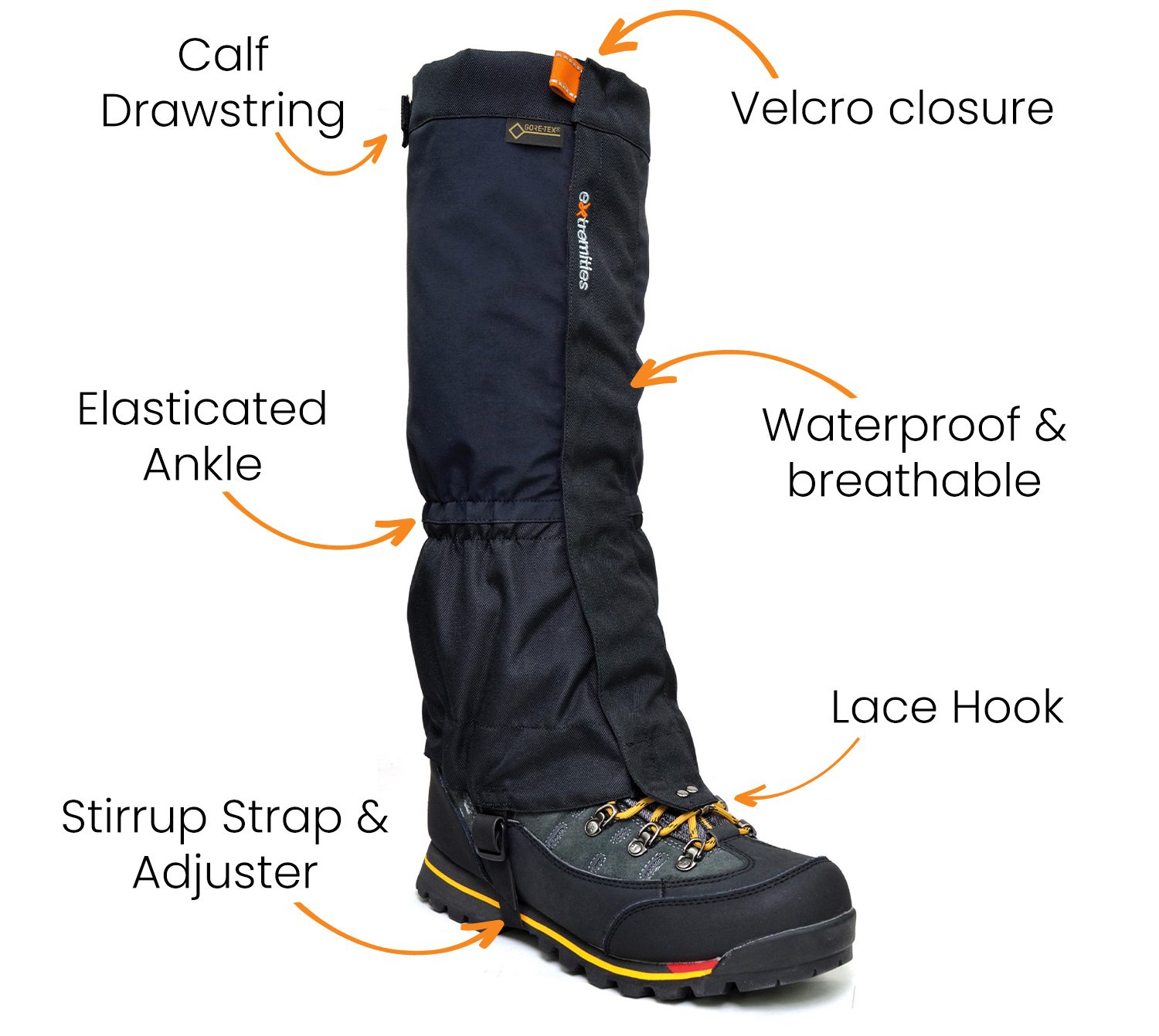Free Delivery Over £50*
You may have encountered the term “gaiters” when shopping for outdoor gear or reading about hiking equipment, but you may still be wondering what they are, or what they’re used for.
If you’re new to hiking and assembling your gear for your first trips, consider adding a pair of gaiters to your kit list. We have put together a guide to eliminate the confusion around gaiters and make you an expert on all thing’s gaiters.
Gaiters are a piece of fabric shielding the space between your trousers and footwear. They have the appearance of a cut sleeve and come with hooks to easily secure them around the ankle and under the boot with a strap.
Gaiters serve as a barrier, preventing water and debris from reaching your legs through the gap between your pants and shoes. With adjustable fastenings and drawcords at the top, gaiters fit tightly around the ankle to provide protection against the elements. Whilst they’re not necessary, gaiters can be a game-changer in rainy climates, as wet boots can be quite uncomfortable and could cause severe foot issues.
When you’re hiking, you’ll encounter debris like stones and mud that can become lodged in your shoes, causing discomfort and blisters. Rainy weather brings with it puddles, mud, streams, and other obstacles that can be difficult to cross. But with gaiters, you can add an additional layer of protection that keeps debris and water out of your boots and socks.
Gaiters can be used at any time in any condition. We recommend using gaiters in muddy, wet, or snowy terrains. They are useful when crossing streams or walking through wet grass or snow. When walking on dry loose ground conditions, gaiters can be worn to prevent small stones and debris from entering your boots.
It is useful to have them handy, but starting the walk with them is not always necessary. Keep gaiters in your backpack so that they can be easily put on in case of a change in weather or terrain.

Ankle gaiters are the most common type of gaiter and attach to the ankle, providing protection from the top of the shoes to the bottom of the trousers. They are the lightest of all gaiters and protect the crucial gap between footwear and clothing. Ideal for hiking in dry and mild weather, these gaiters are best suited for easier terrains and can also be used for trail running.
Mid-length gaiters, measuring 8 to 12 inches in height, are a natural choice between ankle and full-length options. Ideal for less extreme conditions and rainy days, they are perfect for keeping trail debris and rain out of your hiking boots or walking shoes.
Full-length gaiters, a staple among hiking and walking enthusiasts, typically stand at 15 to 18 inches. They provide superior protection for the lower leg, specifically from water, dirt, debris and in wet conditions. Designed for rough conditions, these gaiters are favoured by serious hikers as they ensure a secure fit for the lower half.
Snow gaiters tend to cover more of the foot compared to full-length gaiters. They may also be contoured to fit the shape of ski boots. Their main purpose is to keep snow out while walking, skiing, or snowboarding in deep snow. Salopettes, often have integrated snow gaiters to prevent snow from entering through the gap between the trousers and boots.
We’ve highlighted and explained some of the key features of Extremities Gaiters:

A drawstring allows users to adjust their gaiters for a comfortable yet secure fit.
The 2-inch Velcro strip allows for a secure fit whilst being easy and convenient to take off.
All Extremities gaiters are elasticated at the ankle to improve the fit and prevent water from getting in.
A combination of durable synthetic materials and a breathable, waterproof membrane protects the lower leg from harsh weather conditions and debris.
The stirrup straps wrap around the underneath of the footwear to hold the gaiters in the correct position. The adjuster enables a looser or tighter fit depending on the users’ preferences.
Top tip:
Once the gaiters are secure and comfortable, cut off the excess fabric on the stirrup strap so it doesn’t get in the way.

When trying on hiking gaiters, make sure they fit closely around your boots with no loose areas for moisture to enter. Also, ensure a comfortable fit around your legs and calves, avoiding constriction of circulation
Before each use, inspect the stirrup straps, Velcro closure, and adjustable straps for proper function. Clean the exterior of the gaiters with a cloth after each use and use warm water for deeper cleaning. To maintain their waterproofing, consider using a durable water-repellent spray.
Now that you are an expert on gaiters, it’s time to grab your own pair. Check out our range of gaiters.
Already got a pair of gaiters? Check out the Extremities range of outdoor clothing accessories to complement your gaiters and be ready for any weather condition.